PROTECTING THE DEMOCRATIC VOTE 2:
Prospects for a 34
Seat House Pick Up Look Good
Michael Collins and TruthIsAll
“Scoop” Independent
News
Washington, D.C.
See also… 25 October 2006 - Election Fraud 2006 - Quantifying The Risk
Democrats… may end up riding a wave that would give them both a substantial majority in the House — perhaps a win of more than 30 seats, far greater than the 15 seats they need to net for majority control — and a narrow control of the Senate, winning precisely the six seats they need for control, and perhaps even one more.
- Mark Halperin, ABC News Political Director
Political junkies talk about two elections as they anticipate the November 6 mid term Congressional elections: 1982 and 1994. In 1982, the Democrats picked up 27 House seats as the country said no to the doctrinaire Reagan project. The Senate remained Republican that year. 1994 was a blow out of epic proportions. The Democrats lost 54 seats in the House and eight in the Senate. That election was the “gift that keeps giving.”
The newest faction of the venerable voting rights movement has two entirely different elections that preoccupy it’s small but active ranks as we approach election day: 2000 and 2004. This marked the beginning of the aggressive changes to an election system that for decades had quietly done its mischief in the backwaters of American politics. With the country split down the middle in 2000, spoiled ballots, voter suppression, and digital disruption (voting machine and tabulator problems) assumed a very high profile. After all, 51 million voters watched the candidate they voted against inaugurated as President of the United States. That candidate not only lost the popular vote, he had to rely on his high level handlers and his brother’s good offices to work the system in Florida and Washington for his maximum advantage.
The corporate media is still reeling through its catharsis stimulated by l’affaire Foley. Story after story about Republican corruption, incompetence, and strange and vulgar personal behavior are treated as new discoveries. It is a curious wave of muckraking for a media establishment that has gone so far out its way to make the life and times of George W. Bush as easy as possible despite failure after failure. This not entirely spontaneous remission from their tolerance of all things Bush offers a turning point politically by galvanizing an already furious populous.
The one topic the press will not touch is election fraud. There is an active media insurgency tackling elections issues represented by Lou Dobbs. His excellent reports eviscerate the charade that is electronic voting. A veritable junk yard dog with a bone, Dobbs has been on point for several months doing an exemplary job of exposing the absurdities of our unwanted dependence on truly pathetic electronic voting machines plus the new regime that force invisible voting and tabulation down the throats of a once free people.
He and others are speaking up with greater frequency as election day approaches. They fail to ask one very important question: who benefits again and again? A micro faction of the Republican Party is in the drivers seat operating major state voting systems and defining the laws that require, no mandate, local elections officials to buy equipment from firms either overwhelmingly favorable to the Republicans or whose corporate ownership has yet to be determined.
That’s why it’s left to those in this small but growing community of reality based activists to say the obvious. We have a lousy elections system that favors one party on a consistent basis and systematically distorts the franchise for political purposes. As proof, we’ve seen two presidential elections pilfered through a daring and brilliant array of election tricks.
Our nation has a robust history of election fraud stretching back to the earliest days. The purpose of that fraud has been and remains disenfranchising the poor, minorities, and immigrants and then suppressing their votes when they gain the franchise.
In the spirit of facing realities, the following analysis is offered by mathematician and prolific internet poster TruthIsAll. This analysis is designed to target those races where election fraud and digital disruption are most likely to rear their ugly heads to distort the will of the people.
Please forward this message electronically or in print to your candidates and local party officials.
Forewarned is forearmed.
GENERIC POLLS: The Democrats have won all 110 Generic Polls since September 2005
The following trend analysis is based on the 5-poll moving average based on polls at the PollingReport.Com The margin of error (MoE) for the moving average is 1.41%, assuming a combined sample size of 5000 (1000 per poll). The current Democratic moving average share is 57.8%, assuming a 60% Undecided Voter Allocation (UVA) to the Democrats.
Based on the MoE, UVA, current moving average share (and assuming zero fraud) there is a 97.5% probability that the Generic Democratic vote will exceed 56.4%.
These are probabilities that the Democratic generic vote will exceed the given vote share:
![]()
SENATE POLLING ANALYSIS: The probabilities for Democratic control have tightened somewhat since the October 15 analysis. States to watch for fraud and digital disruption are listed below.
Latest Update: Oct. 28
Current: Republican - 55; Democratic 44; Independent 1
The Democrats need to win 6 of 8 GOP seats to gain control of the Senate
Data Source for latest polls: Real Clear Politics (RCP). Note that the average poll shares are calculated by RCP based on the latest polls.
Let’s simplify things. This is not rocket science. The races to watch closely for fraud are Virginia, Tennessee, and Missouri. These are the closest races: the races where a very tight finish, one of those special last minute wins, would be highly defensible. At least a tight race provides plausible deniability if there were in fact instances of election fraud.
The Democrats need to win two of these races and improve on the probabilities established already to have a better chance of prevailing and taking back both houses of Congress.
The probability is 78% that the Democrats will win the Senate if they get 2/3 (67%) of the undecided vote (UVA), assuming zero fraud. The probability of Democratic control drops to 30% if the undecided vote is 60% Democratic. The win – loss margin is razor thin.
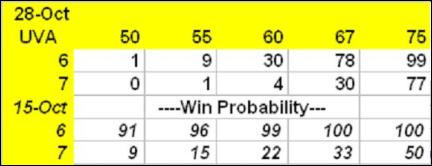
Prior - previous polling (as of 10/15)
RCP - latest polling averages (as of 10/27)
UVA - RCP average adjusted for undecided voter allocation
Assume: 60% UVA to DEM
Latest RCP Poll Average assuming UVA 60% to DEM
RCP=Real Clear Politics
http://www.realclearpolitics.com/epolls/2006/senate/
In order to take back the Senate, the Democrats must win every race that they currently lead. The Tester race is tightening up and Ford and Webb, while they lead briefly, have fallen off a bit. Those two are both strong candidates with a fighting spirit. The final days of the campaign and unexpected events may well determine the outcome. Senate control may very well depend on vigilance by the Democrats to any type of voter suppression or digital disruption in each of these states.
Extreme vigilance is required in the Virginia, Tennessee, and Montana races. A Democratic win in one of these three races is a must. Therefore, they may be target rich opportunities for fraud and disruption.
HOUSE POLLING ANALYSIS: The prospects for a 34 House gain by Democrats look very good presuming zero fraud.
There are 60 Republican seats at play as of October 24th. The Democrats need 15 (net) in order to gain control of the House. They are currently leading or tied in 30. Of those 30 races, the Democrats are leading in 12 beyond the margin of error (MoE), 15 within the MoE, and 3 races are tied.
The Republicans lead in 22 races within the margin of error and in eight beyond the MoE.
Therefore, assuming the Democrats win the 12 races in which their leads are beyond the MoE, then the 18 races in which they currently lead or have a tie must be monitored closely for potential fraud (see below). Fraud potential is based on a race that is within the margin of error.
Monte Carlo Simulation: If the Democrats (conservatively) just split the undecided vote, there is a 100% probability they will capture the House and gain 25 or more seats, assuming zero fraud.
If the Democrats capture 60% undecided voters (UVA), there is a 99% probability they will gain 30 or more seats, assuming zero fraud.
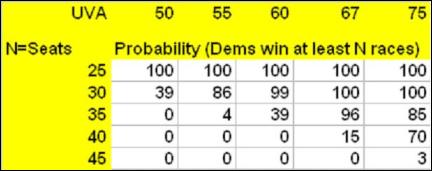
GRAPH
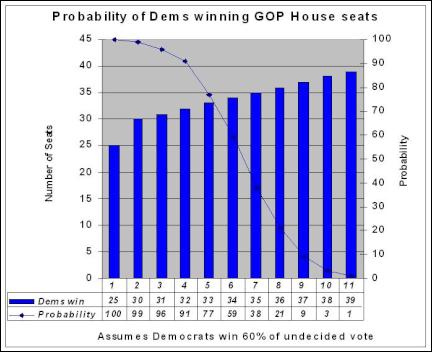
Click for big
version
This graph illustrates the
opportunities for the Democrats to regain control of “the
peoples House.” A 34 seat pick up has a 59%
probability.
There are 60 Republican races where the Democrats are now deemed competitive. The degree of success varies among the three groups below. They are divided into three groups based on their potential for fraud and disruption. If a race is very close, tied or within the margin of error, a narrow win can be justified and then used to hurl the charge of sour grapes or sore loser regardless of the level of irregularities pointing to fraud.
The Democrats lead these races outside of the margin of error. Any problems with these ten races would be immediate triggers for investigation and election contests.
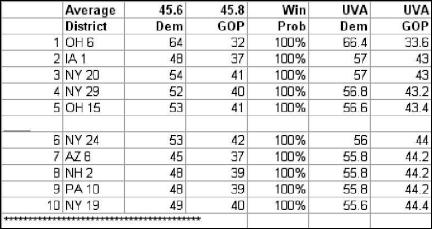
The 25 races below are all within the margin of error or tied. Therefore, they are the likeliest contests to target for fraud or “digital disruption.” They need to be monitored now, throughout election day, thereafter. While candidates claim and concede victory, the vote counting continues for days after any elections. (N.B. No candidate can claim victory or concede a loss absent a final vote count. The votes belong to the people. They are not the emotional and political proxy for exuberant or despondent aspiring public servants.)
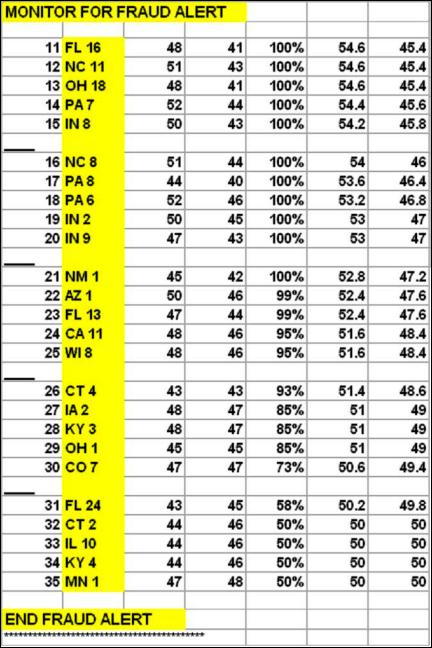
The following 25 races are out side of the “fraud alert zone.” However, like all election races, they should be monitored for any election irregularities.
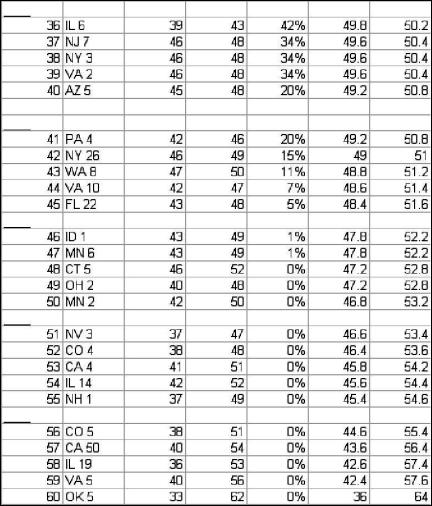
Get involved, demand that your elections are run in a free, fair transparent andinclusive fashion. Campaign for the candidate of your choice regardless of your party affiliation. Those who would perpetrate deliberate election fraud and digital disruption are a microscopic fraction of the body politic, yet the have the potential to ruin the country through any further tricks and deceptions. Don’t let them do it. Participate and shine a bright light on the process. Free, fair, transparent, and inclusive elections work extremely well for each and every citizen of the United States.
Partial list of groups working against voter suppression and election fraud:
- The NAACP - http://action.naacp.org
- Election Defense Alliance - http://www.electiondefensealliance.org/
- League of Women Voters - http://www.lwv.org
- Velvet Revolution - http://www.velvetrevolution.us/
- Advancement Project - http://www.advancementproject.org/
© Copyright: Please feel free to reproduce
and distribute this in any fashion you feel suitable with an
attribution of authorship and the publisher, “Scoop”
Independent News, plus a link to the
article.


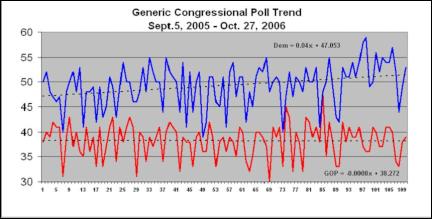

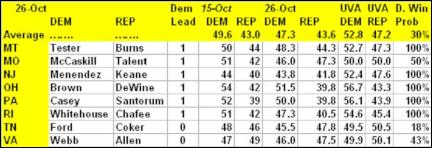
 Richard S. Ehrlich: Deadly Border Feud Between Thailand & Cambodia
Richard S. Ehrlich: Deadly Border Feud Between Thailand & Cambodia Gordon Campbell: On Free Speech And Anti-Semitism
Gordon Campbell: On Free Speech And Anti-Semitism Ian Powell: The Disgrace Of The Hospice Care Funding Scandal
Ian Powell: The Disgrace Of The Hospice Care Funding Scandal Binoy Kampmark: Catching Israel Out - Gaza And The Madleen “Selfie” Protest
Binoy Kampmark: Catching Israel Out - Gaza And The Madleen “Selfie” Protest Ramzy Baroud: Gaza's 'Humanitarian' Façade - A Deceptive Ploy Unravels
Ramzy Baroud: Gaza's 'Humanitarian' Façade - A Deceptive Ploy Unravels Keith Rankin: Remembering New Zealand's Missing Tragedy
Keith Rankin: Remembering New Zealand's Missing Tragedy